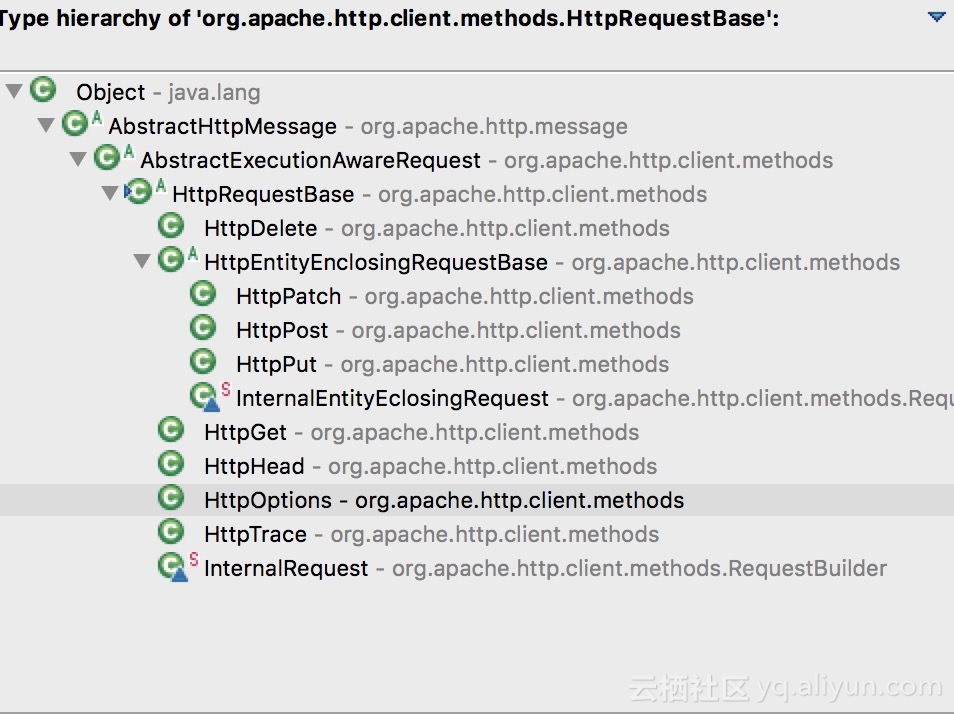一、HttpClient scope
1.Client-side HTTP transport library based on HttpCore
2.Based on classic (blocking) I/O
3.Content agnostic
二、HttpClient能做什么?
1.HttpClient不是浏览器
2.HttpClient只能发送、接收请求,传输数据
3.HttpClient不解析返回数据
支持的请求类型
GET, HEAD, POST, PUT, DELETE, TRACE and OPTIONS.
对应的方法类型
HttpGet,HttpHead, HttpPost, HttpPut, HttpDelete, HttpTrace, HttpOptions.
三、执行请求的基本代码块
CloseableHttpClient httpclient = HttpClients.createDefault();
HttpGet httpget = new HttpGet("http://localhost/");
CloseableHttpResponse response = httpclient.execute(httpget);
try {
<...>
} finally {
response.close();
}
四、Http Request URI的组成与HTTP请求
HTTP request URIs consist of a protocol scheme, host name, optional port, resource path, optional query, and optional fragment.
URI uri = new URIBuilder()
.setScheme("http")
.setHost("www.google.com")
.setPath("/search")
.setParameter("q", "httpclient")
.setParameter("btnG", "Google Search")
.setParameter("aq", "f")
.setParameter("oq", "")
.build();
HttpGet httpget = new HttpGet(uri);
System.out.println(httpget.getURI());stdout
http://www.google.com/search?q=httpclient&btnG=Google+Search&aq=f&oq=五、HTTP Response(这个是指我们调用接口后需要返回消息体给对方)
HttpResponse response = new BasicHttpResponse(HttpVersion.HTTP_1_1,
HttpStatus.SC_OK, "OK");
System.out.println(response.getProtocolVersion());
System.out.println(response.getStatusLine().getStatusCode());
System.out.println(response.getStatusLine().getReasonPhrase());
System.out.println(response.getStatusLine().toString());
stdout
HTTP/1.1
200
OK
HTTP/1.1 200 OK六、设置响应头
读取head的时候有两种方式:
方式一:
HttpResponse response = new BasicHttpResponse(HttpVersion.HTTP_1_1,
HttpStatus.SC_OK, "OK");
response.addHeader("Set-Cookie",
"c1=a; path=/; domain=localhost");
response.addHeader("Set-Cookie",
"c2=b; path=\"/\", c3=c; domain=\"localhost\"");
Header h1 = response.getFirstHeader("Set-Cookie");
System.out.println(h1);
Header h2 = response.getLastHeader("Set-Cookie");
System.out.println(h2);
Header[] hs = response.getHeaders("Set-Cookie");
System.out.println(hs.length);方式二: 使用HeaderIterator
HttpResponse response = new BasicHttpResponse(HttpVersion.HTTP_1_1,
HttpStatus.SC_OK, "OK");
response.addHeader("Set-Cookie",
"c1=a; path=/; domain=localhost");
response.addHeader("Set-Cookie",
"c2=b; path=\"/\", c3=c; domain=\"localhost\"");
HeaderIterator it = response.headerIterator("Set-Cookie");
while (it.hasNext()) {
System.out.println(it.next());
}七、HTTP Entity (HTTP消息实体)
消息体存在于请求体或者响应体中,HttpClient通过内容的源来区分三种消息体:
streamed:
The content is received from a stream, or generated on the fly. Streamed entities are generally not repeatable.
self-contained:
Self-contained entities are generally repeatable, will be mostly used for entity enclosing HTTP requests
wrapping:
The content is obtained from another entity.
补充:The HTTP specification defines two entity enclosing request methods: POST and PUT.
处理流类型消息体时,注意释放资源
CloseableHttpClient httpclient = HttpClients.createDefault();
HttpGet httpget = new HttpGet("http://localhost/");
CloseableHttpResponse response = httpclient.execute(httpget);
try {
HttpEntity entity = response.getEntity();
if (entity != null) {
InputStream instream = entity.getContent();
try {
// do something useful
} finally {
instream.close();
}
}
} finally {
response.close();
}
The difference between closing the content stream and closing the response is that the former will attempt to keep the underlying connection alive by consuming the entity content while the latter immediately shuts down and discards the connection.
译:关闭流消息体和关闭响应的区别是前者通过消费(读取)消息体的内容的方式尝试保持连接的存活,而后者则是立即断开连接。—— (有待于纠正)
在我们使用streaming entities时,我们也可以使用EntityUtils.consume(HttpEntity) 方法来确保消息体的内容全部被读完(or has been fully consumed),并且Stream连接已经关闭。
处理包装类型的资源:(使用背景:在我们想多次使用content的时候我们需要缓存资源)
CloseableHttpResponse response = <...>
HttpEntity entity = response.getEntity();
if (entity != null) {
entity = new BufferedHttpEntity(entity);
}未完待续....





